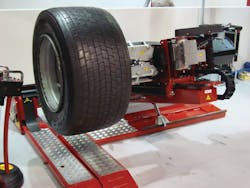As the leading training authority in the truck tire and wheel industry for the past 16 years, we are proud to say that TIA has made a positive impact on the safety and service procedures for technicians. From the equipment perspective alone, the increased usage of restraining devices (safety cages) and torque wrenches has undoubtedly prevented accidents in the shop and on the highway.
In fact, TIA adopted a new tagline, "Tire Safety Starts Here," to reflect the association's ongoing commitment to educating technicians.
Part of that commitment is focused on new technology and how it affects the way that tires and wheels are serviced.
No Watershed Moment
A few years ago, the introduction of wide base single tires as replacements for standard dual assemblies was not considered a watershed moment in the history of truck tires. There were only two manufacturers that embraced the technology at the time and only a fraction of the service outlets jumped on board right away and kept them in stock.
The benefits of wide base single tires were primarily focused on the weight savings, so a small number of fleets were targeted, most of them at the local level.
But then things changed. Once diesel hit $4.00 a gallon, fleets became obsessed with finding ways to improve fuel mileage. Since even the slightest improvement can translate into thousands, if not millions, of dollars in savings, companies that previously had no interest in wide base singles started to explore the possibility of replacing standard dual assemblies strictly for the fuel savings.
As a result, the popularity of these tires has grown to the point where there are multiple manufacturers and they are now readily available at tire dealers and truck stops from coast to coast.
Service Issues
From the service perspective, wide base single tires create a number of issues due to the size and weight of the assemblies.
The typical wide base single tire weighs somewhere in the neighborhood of 200 lbs, while an aluminum wheel checks in around 60 lbs. Swap the aluminum wheel for a steel wheel and the total weight of the assembly jumps to over 300 lbs.
For the average technician used to handling standard dual assemblies that typically weigh less than 200 lbs, the extra 60 to 100 lbs per tire is going to take a toll on the body over time. As a result, companies are being forced to make some changes regarding the servicing of these tires.
A Tricky Process
For most people, the obvious solution is to just demount and mount wide base single tires while they are still installed on the axle. It solves the problem of lifting the extra weight, but also creates some issues when demounting the back bead because the technician is put in a somewhat awkward position with a standard tire iron.
It's also important to note that the mounting process can be tricky, particularly when mounting the back bead with a tire iron, since hammers should never be used to strike the beads of a tire at any time.
Then there is the issue of seating the beads when the tire is in a vertical position. Concentric bead seating is just one of the factors that are extremely important if smooth and even tread wear is desired on wide base singles. When the assembly is not laying flat, the margin for error increases.
Challenges with Demounting and Mounting
For those companies that decide to remove the assembly from the vehicle prior to demounting and mounting, an entire new set of challenges is created.
The standard tire iron does an average job of acting as a wheel dolly on standard dual assemblies, but the size and weight of wide base singles reduces the effectiveness. Heavy duty wheel dollies are the best tools to ensure the assembly is removed and installed without risking injury to the technician or damage to the studs.
As far as demounting and mounting is concerned, specialty tools have been designed to handle the extra width so the tire can be demounted without lifting the assembly. But they don't always work, and they require some patience and/or precision on the part of the technician so most shops just add some extra muscle and use standard tire irons.
Regardless of which hand tools are used, generous amounts of bead lubricant during the demount process are necessary to make the process easier. Likewise, the mounting process requires lubricant on the bead and rim surfaces to help ensure the beads are not damaged and the tire is seating concentrically.
Other Concerns
It's also important to note that more and more tire service providers are starting to explore the usage of tire changing machines when demounting and mounting wide base singles.
Undoubtedly there is an increased time factor when compared to hand tool methods, but the wear and tear on technicians is going to add up over time if these assemblies become even more popular and shops continue to service them by hand.
From the inflation standpoint, special restraining devices are necessary since the standard models are not wide enough to accommodate wide base singles. While Occupational Safety and Health Administration (OSHA) regulations allow a single piece assembly to be inflated on the vehicle if the lug nuts are fully tightened, the Rubber Manufacturers Association (RMA) inspection guidelines for potential zipper ruptures recommends that all tires returning to service be inflated in a restraining device so both sidewalls can be inspected.
Since the prospect of fuel prices falling below $3 a gallon are slim to none, the number of vehicles with wide base single tires will continue to increase each year. As a result, service providers and maintenance personnel need the proper training and equipment to handle them safely.
About the Author

Tire Industry Association
The Tire Industry Association (TIA) is an international association representing all segments of the tire industry, including those that manufacture, repair, recycle, sell, service or use new or retreaded tires, and also those suppliers or individuals who furnish equipment, material or services to the industry. TIA was formed by the July 2002 merger of the International Tire & Rubber Association (ITRA) and the Tire Association of North America (TANA). TIA’s main office is in Bowie, MD. The association has more than 6,000 current members.
